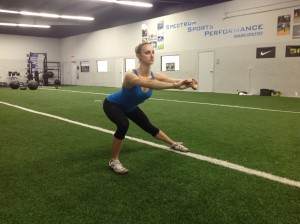By: Steve Yahns, MS, CSCS, NASM-PESAssistant Director of Performance, Lead Methodology EducatorSpectrum Sports PerformanceVolleyball Specific Exercise, Series 2
In part 1 of this article I mentioned how muscular imbalances and postural deviations are everywhere in athletics, and even everyday life. We also previously talked about the importance of beginning to correct these imbalances to prevent injuries and increase performance in volleyball players. If we fail to increase muscle flexibility and tissue length prior to intense training sessions, we could possibly put these athletes – and their training progress – at risk.
The focus of this article is to discuss the importance of ensuring a proper “warm-up” before a volleyball practice, game, or training session. The purpose of a warm-up is to prepare the body for the demands of the upcoming training session, practice or game. It should aim to increase blood flow throughout the entire body, while taking joints and muscles through similar ranges of motion and positions that they will use during the training session to follow. It’s pretty obvious that a volleyball player is putting their body through various positions throughout a game and practice, as well as their training sessions. Remember that muscle imbalances can limit the body’s ability to get into certain positions effectively, therefore limiting proper movement and possibly increasing the risk for injury. Since we are trying to prepare the body for movement during our warm-up, we are going to refer to the warm-up as a “movement preparation” session. Stretching the body is an important component of any movement prep session, and while muscle imbalances can exist throughout the body, a majority of issues stem from tightness throughout the hip complex. We spoke about tight hip flexors in the previous blog, and how they can severely hamper performance, in addition to creating numerous other problems.
Movement Prep: Dynamic Flexibility
Dynamic flexibility is a functional-based warm-up consisting of movements that will prepare the body for sport. The main difference between dynamic stretches and static stretches (where the end position of a stretch is held for an extended amount of time) is that dynamic stretches are held for only a few seconds, and are performed by taking the body through a range of motion or movement pattern that will pertain to the upcoming exercise session.
As mentioned above, it’s important for every volleyball player to make sure they are addressing tightness throughout the hip complex. Increasing flexibility in this area will allow them to be able to jump, dig, and hit more efficiently – as well decreasing the risk of a knee or ankle injury.
Exercise #1: Lunge w/Elbow to Instep As we know by now, tight flexors are very common and can be a very big problem. This stretch aims at lengthening the hip flexor, especially when the back leg is straight and the back Glute is flexed. Proper posture is also of utmost importance, as one should see a straight line from the top of the head through the heel of the athlete. Usually we have an athlete do 3-5 reps on each leg, holding each stretch for roughly two seconds.
As we know by now, tight flexors are very common and can be a very big problem. This stretch aims at lengthening the hip flexor, especially when the back leg is straight and the back Glute is flexed. Proper posture is also of utmost importance, as one should see a straight line from the top of the head through the heel of the athlete. Usually we have an athlete do 3-5 reps on each leg, holding each stretch for roughly two seconds.
Exercise #2: Lateral Lunge This is another very effective stretch used to prepare the body for activity. The inner medial section of the hip is actively being lengthened on one side, while the opposite side is being taken through a nice deep lunge position. This stretch can directly begin to improve mobility of the hips, while also stretching that inner thigh and hip. Once again, posture is very important, as is maintaining a totally straight leg on the side away from where we are lunging. Athletes should also attempt to keep both toes straight ahead. Usually an athlete will hold each stretch for around two seconds and would do around 3-5 reps on each side.
This is another very effective stretch used to prepare the body for activity. The inner medial section of the hip is actively being lengthened on one side, while the opposite side is being taken through a nice deep lunge position. This stretch can directly begin to improve mobility of the hips, while also stretching that inner thigh and hip. Once again, posture is very important, as is maintaining a totally straight leg on the side away from where we are lunging. Athletes should also attempt to keep both toes straight ahead. Usually an athlete will hold each stretch for around two seconds and would do around 3-5 reps on each side.
Leave a Reply